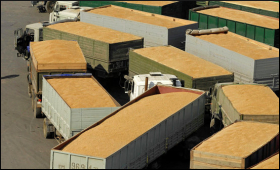|
|
|

|
Kharif 2022: Rice, oil seeds sowing less, pulses, coarse cereals more over 2021
|
|

|
|
| Top Stories |
 |
|
|
|
IANS | 02 Jul, 2022
As large parts of central and northwest India witnessed delayed monsoon,
sowing for Kharif season's mainstay rice and oil seeds has decreased
compared to last year, even as that for pulses and coarse cereals has
increased, even if slightly, government data showed on Friday.
Kharif
sowing has taken place over a total of 278.72 lakh hectares (ha), 15.70
lakh ha less compared to 294.42 lakh ha last year this time, a dip of
5.33 per cent. The Southwest Monsoon has had slow progress over central
and south peninsular India and after a small hiatus, was active earlier
this week. As of Friday, except for some parts of Rajasthan, it has
covered the rest of the country.
But it is not just this year -
several areas are witnessing delayed monsoon rains for a longer time
now. "Rainfall has been delayed regularly for the last decade or so.
(Therefore), we have seen that farmers in our belt start sowing only by
June end or July first week," said N.S. Tomar, Joint Director, Gwalior
division in Madhya Pradesh Agriculture Department.
"For paddy,
the nurseries are done while for bajra, maize, and jowar, the sowing has
started only now," he said, adding that the state has seen an increase
in paddy, maize, and jowar this year.
T.N. Prakash Kammardi,
former Professor and the head of Department of Agricultural Economics at
the University of Agricultural Sciences, Bengaluru, pointed out how the
delay in sowing will, in turn, delay production of oil seeds and
cereals. "We don't yet have varieties that can deal with delay or
failure in monsoon; it is high time we get such seeds."
"Also,
given the changing climatic conditions, we need to keep in mind that
when it comes to monsoon rainfall, uncertainty will be the rule while
normal will be an exception," said Kammardi, who was also the former
Chairman of the Karnataka Agricultural Prices Commission (KAPC).
Data
from the Union Ministry of Agriculture showed that rice is sown over
43.45 lakh ha, compared to 59.56 lakh ha in 2021, which is 16.11 lakh ha
less (minus 27.05 per cent).
Pulses have been sown over 28.06
lakh ha, compared to 26.23 lakh ha in 2021, which is 1.83 lakh ha more
(plus 6.99 per cent), among them, moong and other pulses have witnessed
higher sowing area while arhar, kulthi, and urad have witnessed far
lesser sowing compared to last year. At 10.76 lakh ha and 3.18 lakh ha,
moong and other pulses are 31.81 per cent and 71.52 per cent higher
compared to last year's.
Total coarse cereals have also witnessed
a decline with 46.34 lakh ha compared to 50.36 lakh ha in 2021, a
decline of 4.01 lakh ha (minus 7.97 per cent). Of them, bajra has seen
the maximum sowing with 15.01 lakh ha compared to 10.23 lakh ha in 2021
(plus 46.72 per cent) while jowar is yet to pick up with only 1.78 lakh
ha sown area compared to 2.75 lakh ha in 2021, a decline of 35.10 per
cent.
Even the oil seeds saw relatively lesser sowing at 46.34 lakh ha compared to 50.36 lakh ha last year (minus 7.97 per cent).
The
government data also showed that even sugar cane has seen a decrease
with 52.92 lakh ha sown areas compared to 53.41 lakh ha last year, less
by 0.91 per cent.
|
|
|
| |
|
|
|
|
|
|
|
|
|
|
|
|
|
|
| |
| Customs Exchange Rates |
| Currency |
Import |
Export |
US Dollar
|
₹91.25
|
₹89.55 |
UK Pound
|
₹122.85
|
₹118.85 |
Euro
|
₹107.95
|
₹104.3 |
| Japanese
Yen |
₹59 |
₹57.1 |
| As on 29 Dec, 2025 |
|
|
| Daily Poll |
 |
 |
| What is your biggest hurdle to scaling right now? |
|
|
|
|
|
| Commented Stories |
 |
|
|
|
|
|
| |
|